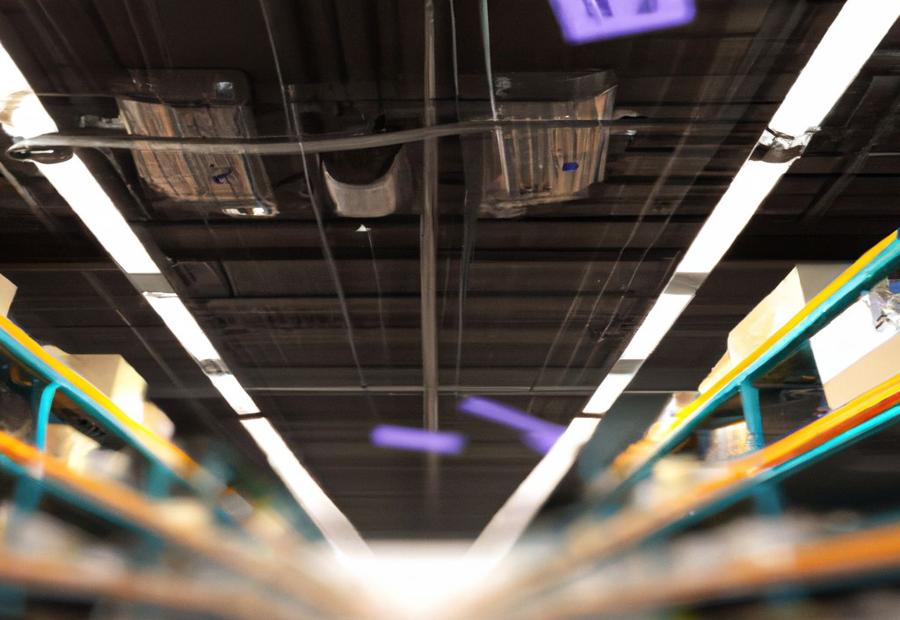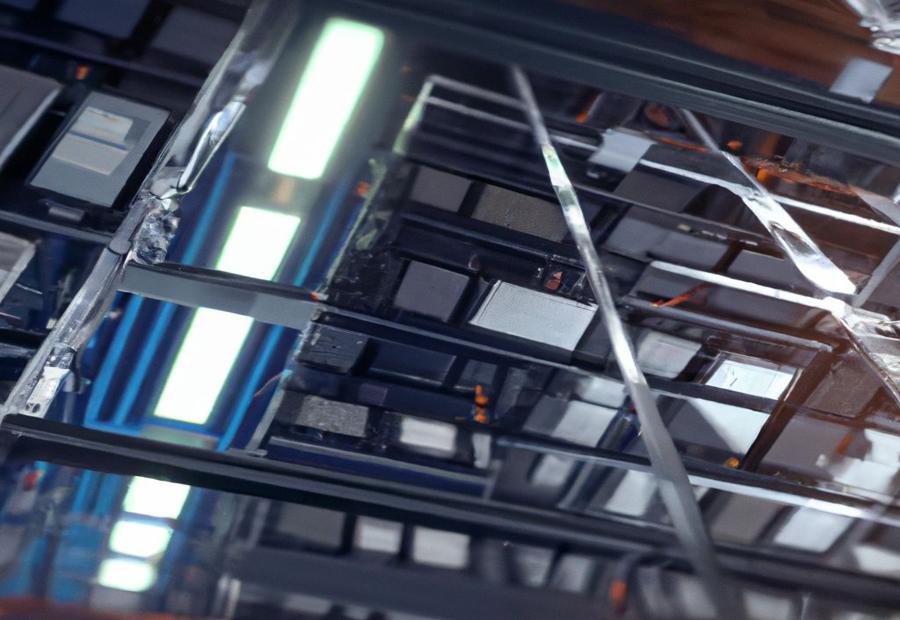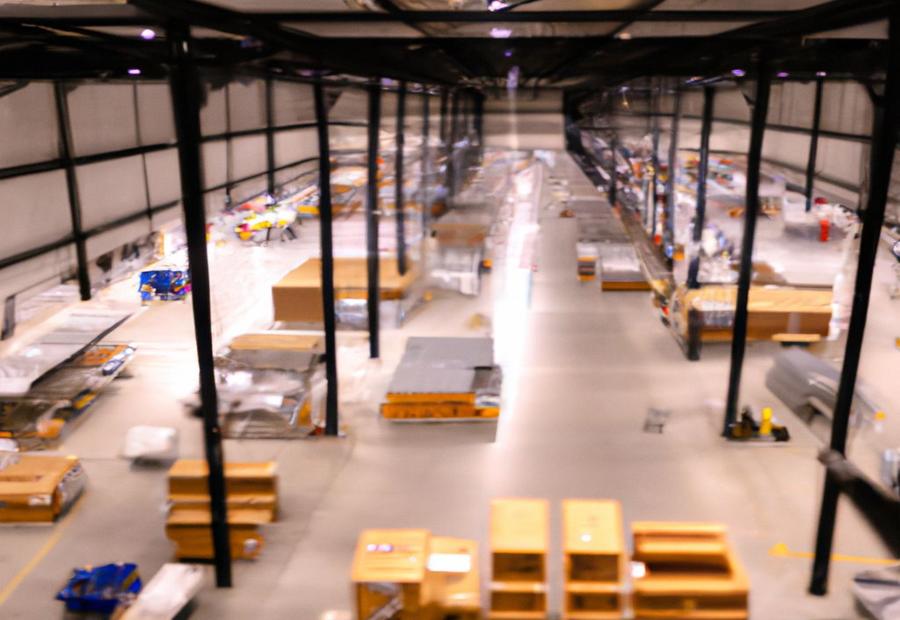Key takeaway:
- Evolution of technology in modern warehouse construction has led to numerous benefits and advancements in the industry.
- Warehouse automation and information technology applications are current trends that have revolutionized the efficiency and productivity of warehouses.
- In the future, machine learning, artificial intelligence, autonomous robots, blockchain technology, and IoT sensors are expected to play a significant role in modern warehouse construction, improving operations and optimizing resource utilization.



Photo Credits: Build-Wire.Com by Jacob Mitchell
Modern warehouse construction has undergone a remarkable transformation, thanks to the ever-evolving role of technology. From the immense strides in automation to the integration of cutting-edge software systems, this section will explore the fascinating evolution of technology in modern warehouse construction. Moreover, we will delve into the myriad benefits that these technological advancements bring to the realm of modern warehousing, revolutionizing efficiency, productivity, and overall operational excellence. Get ready to uncover the exciting changes that are reshaping the landscape of warehouses worldwide.
Evolution of Technology in Modern Warehouse Construction
Years have seen significant evolution of tech in modern warehouse construction. This evolution has been crucial in revolutionizing warehouses, leading to greater efficiency and productivity. Automation, IT apps, and modern tech integration have made warehouses more sophisticated and streamlined.
Automation is a main trend. Automated systems help with material handling, inventory management, and order fulfillment. They are faster and more accurate than human workers, reducing errors and speeding up order processing.
IT applications have had a major impact. Warehouse management systems (WMS) enable real-time tracking of stock, optimizing storage space and streamlining picking processes. Data analytics tools allow operators to analyze data to find trends, enabling them to make better decisions on inventory and resource management.
Integrating different technologies into one system is another factor. It leads to smooth communication between components in the warehouse ecosystem, improving efficiency.
Benefits of Technological Advancements in Modern Warehousing
Technological advances are transforming modern warehousing, yielding numerous advantages. Automation and IT apps boost efficiency, while integrated systems and software optimize inventory management. Safety is enhanced too, with fewer manual handling risks and improved security tech. Space utilization is also optimized, thanks to automated storage and retrieval systems and smart shelving solutions.
Emerging tech like AI and machine learning predict demand, while Autonomous Mobile Robots and AGVs enable efficient material handling. Blockchain-IoT combos offer traceability throughout the supply chain.
In summary, tech advances have revolutionized warehousing, optimizing operations, inventory management, safety, and space utilization. As tech evolves, further innovations promise to shape the future of modern warehouses – leaving forklift drivers feeling a bit… shelved.
Current Trends in Warehouse Technology



Photo Credits: Build-Wire.Com by Lawrence Rivera
In the fast-paced world of warehouse construction, staying up-to-date on the latest technology trends is crucial. This section delves into the current trends in warehouse technology, exploring the impact and potential benefits of warehouse automation, information technology applications, and integrating modern technology. Get ready to discover how these advancements are reshaping the landscape of warehouse operations and revolutionizing efficiency and productivity.
Warehouse Automation
Warehouse automation is the use of tech and machinery to streamline and optimize operations like inventory control, order fulfillment, and material handling. This tech has become more popular in warehouse construction as it can up efficiency, cut costs, and raise productivity.
Benefits include:
- Higher Efficiency: Automated systems can finish tasks much faster and with higher accuracy than people, so errors reduce, time isn’t wasted, and performance rises.
- Optimized Inventory Management: Automated systems accurately track inventory, making sure stock levels are always ideal.
- Better Order Fulfillment: Automated systems pick, pack, and ship orders quickly and accurately, cutting time and preventing errors.
Plus, warehouses can stay competitive with advanced tech like AS/RS, robotic pickers, and conveyor systems, allowing them to save on labor and get better customer satisfaction and profits. As tech keeps developing, further innovations are likely to emerge, revolutionizing warehouse automation.
Information Technology Applications
Information technology applications are a must for modern warehouse construction. They involve a variety of technologies and systems to improve efficiency, productivity, and accuracy. Advanced software systems, data analytics, and communication networks enable warehouses to automate processes. Inventory management and order fulfillment are optimized. Furthermore, integration with other supply chain partners is made seamless.
Warehouse Management Systems (WMS) have a huge role in information technology. WMS gives real-time control and visibility over warehouse operations. This permits efficient order picking and replenishing, by tracking inventory levels, locations, and movement.
Barcode and RFID technology are popular in modern warehouses for product identification and tracking. Scanning barcodes or RFID tags on items streamlines inventory management.
Cloud computing offers scalability, accessibility, and data security. Warehouses can store data, run algorithms for demand forecasting or optimization, and collaborate with external stakeholders.
Data analytics is important in information technology applications. Warehouses access data from sources such as sensors, machines, or customer interactions. Predictive modeling or machine learning algorithms provide valuable insights to inform decisions.
E-commerce integration is essential in the online shopping-dominated landscape. Information technology applications automate tasks such as order validation, inventory updates, and shipping notifications. Thus, orders are processed smoothly from placement to delivery.
These information technology applications are vital in modern warehousing. Manual errors and inefficiencies are eliminated, providing real-time visibility and control over warehouse processes. By integrating these applications, warehouses attain higher levels of productivity, accuracy, and customer satisfaction.
Integrating tech into warehouse operations is like pairing robots and humans. This creates the ideal duo for storage efficiency and comedy!
Integrating Modern Technology
Modern warehouse construction now involves the use of cutting-edge technologies. This means incorporating advanced hardware and software systems that work together to optimize operations. With this integration, warehouses can streamline tasks like inventory management, order fulfillment, and logistics. It’s essential in today’s fast-paced business world, to stay competitive and meet customer demands.
The integration of modern tech has revolutionized warehouse tasks. A significant trend is automation, where machines and robots take over repetitive tasks quickly and precisely. Automated systems can do material handling, sorting, packing, and even inventory management. Information technology applications also play a role in integrating tech. Warehouse management systems (WMS), analytics tools, and real-time tracking systems help optimize workflow.
Moreover, modern tech brings multiple technologies together, like machine learning and artificial intelligence with autonomous mobile robots and automated guided vehicles. This creates intelligent systems that learn and adapt to dynamic environments. Warehouses can gain higher operational efficiency and accuracy with this integration.
Jump into the future of warehouse construction – where machine learning and AI are the drivers!
Future Perspectives in Modern Warehouse Construction



Photo Credits: Build-Wire.Com by Kevin Brown
As we explore the future perspectives in modern warehouse construction, we delve into the transformative role technology plays in this industry. From machine learning and artificial intelligence to autonomous mobile robots, automated guided vehicles, blockchain technology, and IoT sensors, these advancements are reshaping how warehouses operate and optimizing logistics processes. Let’s uncover the ways in which these technological innovations are revolutionizing the modern warehouse landscape.
Machine Learning and Artificial Intelligence
Harness machine learning and AI to boost warehouse productivity and efficiency! Real-time inventory tracking and monitoring lead to greater accuracy in stock management. Predictive maintenance models created through machine learning algorithms can even anticipate potential equipment failures and reduce downtime. AI and ML can also optimize supply chains by predicting demand patterns and optimizing inventory levels. This ensures customers are well-served while cutting costs. Plus, these technologies offer valuable insights into customer preferences and market trends for smarter decision-making.
No more human-pushed carts! Autonomous mobile robots and automated guided vehicles are moving in.
Autonomous Mobile Robots and Automated Guided Vehicles
Autonomous mobile robots (AMRs) and automated guided vehicles (AGVs) are transforming warehouse construction. They don’t need humans to operate! AMRs use sensors, cameras, and mapping tech to move goods in real-time. AGVs follow markers, carry heavy loads accurately, and optimize their routes.
The combo of AMRs & AGVs means goods move seamlessly. AMRs move them to a central location, where AGVs take over. This boosts productivity.
These technologies bring lots of advantages. They improve safety, accuracy, and efficiency with 24/7 operation. Plus, they provide real-time data collection to optimize warehouse operations. Also, they make operations more sustainable – by reducing energy consumption & optimizing routes.
To make the most of these technologies, careful planning is key. Do a feasibility study & compatibility check with existing systems & processes.
Pro Tip: Implement AMRs & AGVs in your warehouse to boost efficiency & reduce costs.
Blockchain Technology and IoT Sensors
Blockchain tech and IoT sensors have become essential for modern warehouse construction. They have transformed supply chain management by providing secure, transparent systems for managing inventory and tracking goods.
Blockchain tech creates immutable records that can’t be changed, ensuring data integrity. This improves trust between stakeholders. Meanwhile, the sensors monitor essential details like temperature, humidity, and location. This makes inventory management easier and reduces operational inefficiencies.
From an operational view, blockchain tech streamlines processes by creating a decentralized ledger. This eliminates the need for middlemen, reducing costs and making processes faster. Smart contracts automate tasks like payment processing and order fulfillment.
IoT sensors provide real-time data that can be stored on the blockchain. Warehouse managers can use them to track parameters like temperature and humidity. They also help track the location of items, reducing the risk of loss.
Going forward, blockchain tech will find wider applications beyond inventory management. For example, digital identity solutions can improve security. Automated asset tracking systems streamline supply chain logistics. And machine learning algorithms and AI techniques process data to further optimize warehouse operations.
Conclusion



Photo Credits: Build-Wire.Com by Michael Gonzalez
To sum up, technology has revolutionized warehouse construction. Automated systems, advanced software, and data analytics have increased efficiency, safety, and sustainability. As technology continues to advance, it is expected that future warehouses will be even more technologically advanced and sustainable.
Some Facts About The Role of Technology in Modern Warehouse Construction:
- ✅ Integration of technology like IoT sensors and WMS technology has improved real-time tracking and control in warehouses. (Source: Team Research)
- ✅ Automation and robotics have reduced the need for manual labor in warehouses, increasing employee safety and improving inventory accuracy. (Source: Team Research)
- ✅ Drones are used for stock counting, inventory control, and picking of goods, improving inventory accuracy in warehouses. (Source: Team Research)
- ✅ Cloud computing and logistics software automate inventory counts and management, increasing warehouse productivity. (Source: Extensiv)
- ✅ Advanced data analytics help warehouses track and improve their processes, boosting predictive analytics and inventory planning. (Source: Logistics Bureau)
FAQs about The Role Of Technology In Modern Warehouse Construction
What is the role of technology in modern warehouse construction?
Technology plays a crucial role in modern warehouse construction by improving efficiency, accuracy, and cost-effectiveness. The integration of internet-connected devices, robotics, and scanning technologies enables real-time tracking, automation, and better inventory management.
How does technology contribute to warehouse efficiency?
Technology integration, such as WMS technology and AI solutions, streamlines warehouse activities by reducing manual labor, optimizing picking efficiency, and utilizing automated vehicles. Real-time tracking, barcode scanning, and stock counting improve inventory accuracy, saving time and resources.
What are the benefits of technology in warehouse operations?
Technology in warehouses offers several benefits, including increased picking efficiency, reduced labor requirements, improved employee safety, and enhanced inventory accuracy. It also enables paperless operations, streamlines processes, and provides better visibility for tracking and control.
How has the COVID-19 pandemic influenced warehouse technology?
The COVID-19 pandemic has accelerated the adoption of technology in warehouses. With surges in ordering, warehouses have relied on robotics, autonomous vehicles, and AI-driven systems to meet increased demand while minimizing human contact.
What are some emerging warehouse technologies?
Emerging warehouse technologies include the rise of autonomy, driverless vehicles, and the use of drones for stock counting and inventory control. Voice technology, cloud computing, and advanced data analytics are also reshaping warehouse operations and improving productivity.
How can technology contribute to a safer and more sustainable warehouse environment?
Technology, such as automated systems, robotic assistance, and process modeling tools, reduces manual labor and the risk of accidents, promoting employee safety. Additionally, paperless operations, barcode scanning, and warehouse audit tools contribute to a more sustainable and environmentally friendly warehouse.
